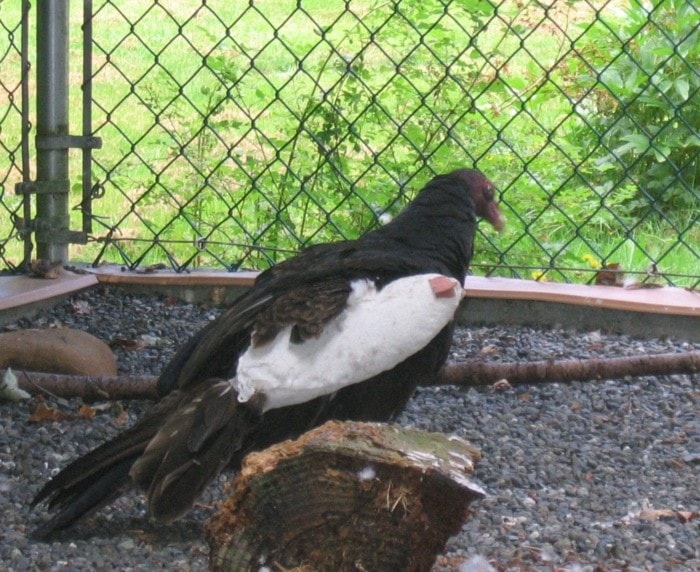There are many reasons why wildlife is admitted to MARS.
This year, many of our patients have been admitted due to impacts with a variety of vehicles. We have seen many fawns, eagles, songbirds to name a few that have perished or been badly injured as they attempted to cross a road.
The latest victim is not a common visitor to MARS, but is a very interesting bird.
Long perceived as disgusting, ugly birds, turkey vultures are actually incredibly fascinating creatures with some unusual features and habits. Their Latin name, Cathartes Aura, means purifier and the Cherokee Indian tribe called them the peace eagle due to their non-aggressive behaviour.
For years these birds were classified as raptors, but extensive studies of their habits, anatomy and DNA proved them to be related to the stork family. They certainly lack many raptor features.
They do have talons but they have weak, flat feet which are not designed for grasping; beaks are short and not powerful or sharp enough to kill prey. Unlike eagles they do not rely on their eyesight to locate prey, rather they detect prey by smell. The part of the brain that processes smell is larger than any other avian or mammal species and they can detect the gasses produced by rotting carrion.
Large dark brown birds that are often mistaken for bald eagles, turkey vultures have a wing span of 170-183 centimetres and can weigh between 850 grams to 2.2 kilos.
Often seen in groups, turkey vultures use the thermal currents to soar together, they carry their wings in a distinct V-shape but seldom flap their wings, they just turn to gain altitude.
Up close there is little doubt which is the vulture as these birds have featherless, red wrinkled heads, (juvenile heads are dark grey or black). Instead of a curved yellow beak the vulture's is ivory with a single large hole through the middle, which is their nostril.
This bald-headed modification is thought to have evolved to prevent "feather rot" due to their feeding habits, which require them to bury their heads inside a carcass; preening head feathers is not an easy task for any bird.
Scavengers by nature they are not known to kill their food. Animals and fish are their main diet but they also include vegetation.
Turkey vultures have a very smart but repulsive way of protecting themselves and their food from predators, if cornered they will regurgitate or projectile vomit over their food or intruder. Very few predators will be tempted to stick around to eat!
Probably they have to resort to these habits as a means of defence as unlike other birds they lack vocal organs and are only able to groan and hiss. Often accused of spreading disease these vultures are an important part of cleansing our ecosystems, especially in arid areas.
Their digestive systems are extremely efficient and their immune systems very sophisticated, which prevents them from contracting diseases or from passing on any disease through their feces. These birds can often be seen standing with their wings open, which is a method of cooling down or drying off their feathers, it also bakes off any bacteria or parasites they make have.
Turkey vultures also have very efficient kidneys allowing them to store water; in very hot conditions they will actually defecate on their own legs, just like storks, which cools their body through evaporation.
During the breeding season turkey vultures do not build intricate nests, they lay their eggs on the ground in caves, crevices, animal burrows, hollow logs or even abandoned buildings, usually they produce two chicks.
Adult vultures have few predators. Often these birds are hit by cars as they dine on road kill, but the young fledgling birds are prone to attacks from eagles, owls, crows and ravens.
The unfortunate turkey vulture that came to MARS was hit by a garbage truck and somehow managed to flip up over the truck and land inside. Fortunately for the vulture, the truck had just been emptied, but not so great for MARS volunteer Reg, who had to climb in to retrieve the hissing vulture.
After an examination at Van Isle Vet Clinic it was confirmed that the vulture had a severely broken wing, which required lengthy surgery to insert pins into the wing bones. To prevent the vulture from picking at the wound it was fitted with a "worry peg" to pick at instead of the dressings.
The vulture continues to have daily dressing changes to prevent infection and it still faces several more weeks of rehab. Our thanks to Van Isle and the other veterinarians who donate hours of their time to help injured wildlife.
Be sure to watch out for these "cool" birds later this month as they are gathering in flocks ready to make the fall migration back to southern California and beyond.
• • •
Thanks to Elizabeth for her article on the fawns, we continue to admit late arrivals. To report injured or abandoned wildlife, please call 1-800-304-9968, for all other calls, 250-337-2021.
Sandy Fairfield is the educational co-ordinator for the Mountainaire Avian Rescue Society (MARS). The MARS column appears every second Friday.
